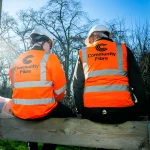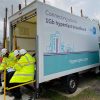UPDATE3 BT Unveil Universal 5-10Mb Broadband and 500Mb G.fast Rollout
As predicted yesterday BT has today announced a new roll-out plan for delivering faster broadband (at least 5-10Mbps) connections to the hardest to reach final 5% of premises in the United Kingdom (mostly rural homes) and an aim to push “ultrafast” 300-500Mbps G.fast to 10 million premises.
Until now the Government’s national Broadband Delivery UK programme has been busy working predominantly with BT, and a few smaller ISPs, to bring superfast broadband (24Mbps+) connectivity out to 95% of premises by 2017/18, although a plan and funding for connecting the most expensive to reach final 5% isn’t expected to surface until the Autumn Statement on November 25th.
Advertisement
In the meantime BT’s CEO, Gavin Patterson, has today moved to counter the operator’s critics by setting out his vision for Britain’s Digital Future, which includes the following commitments. A new report was also unveiled by consultants KPMG, which values the impact of BT’s future commitments as being worth £20-£30 billion to the UK economy over the next decade.
Gavin Patterson, BT CEO, said:
“For the past five years, the UK has been the largest digital economy in the G20, by percentage of GDP. We think the UK has an even brighter future ahead if we make the right decisions today.
We want to forge an ultrafast future for Britain and stand ready to help government deliver the broadband speeds necessary for every property to enjoy modern day internet services, such as high definition TV streaming and cloud computing. To achieve this, we need a collaborative effort across industry and government.”
BT’s Vision – Britain’s Digital Future
1. Aim for a new universal minimum broadband speed of 5-10 Megabits per second (Mbps) for every home and business, “subject to regulatory support“. This includes a plan to extend “fibre broadband” (FTTC/P) coverage beyond the government’s 95% target, using new technologies such as Extended Reach VDSL2 (FTTC) and Wireless-to-the-Cabinet (WTTC). No firm date is given for when this universal commitment might be achieved or what “regulatory support” would be required.
Part of this will be achieved thanks to the “success dividend” (clawback / gain share) clauses in contracts covering rollout co-funded by BT, Whitehall and local councils. The clauses mean BT has to reinvest or return money if take-up exceeds certain levels in areas where public funds have been used. A sum of £130m is already being released and could push “fibre broadband” to 96% of premises.
2. The next generation G.fast broadband technology, which will launch with top speeds of up to 300Mbps and be boosted to 500Mbps within 10 years, will be deployed out to reach 10 million premises by the end of 2020 (this is around 40% UK coverage, the same coverage as the operators original 2009/10 deployment plan for FTTC/P connectivity) and “most of the UK” will be done by 2025. Previously BT has envisaged the roll-out for this beginning in 2016/17.
3. A 1Gbps service will be provided for those that want even faster speeds, which we assume is the soon-to-be reintroduced and often heinously expensive FTTP based Fibre-on-Demand (FoD2) product that is currently being trialled alongside G.fast. Most homes would not be able to afford this service at the previous price point and it’s often envisages more as a small business solution, despite lack some key business connectivity features.
It’s also expected that BT’s native Fibre-to-the-Premises (FTTP) product may continued to be rolled out to more areas, which is much more affordable than FoD (with FoD you effectively have to cover part of the expensive street works cost yourself). But so far it’s not clear how much further this will be pushed.
4. BTOpenreach’s new “View My Engineer” service, which is already being deployed (started only a few weeks ago), will also improve the customer experience by giving text progress updates to end-users and the engineer’s mobile phone number.
5. BTOpenreach has also committed to increase on-time customer installations beyond Ofcom regulated levels in new Charter. Garner stated his ambition to exceed, by 6%, Ofcom’s 2017 minimum standards for delivering new connections on-time.
6. BT will also introduce its own a Satellite broadband service for some of the UK’s more remote premises by the end of the year (focus on the final 1-2%).
7. BTOpenreach also announced plans to supply “fibre broadband for all new housing developments“, either through BT’s own efforts or in cooperation with developers.
It’s of course no secret that BT are under a lot of pressure right now, not least from rivals that want to see them being broken-up (here) and Ofcom’s related strategic review. At the same time the Government are also mooting a new 5Mbps Universal Service Obligation (USO) and have been nudging BT to make a bolder commitment for future connectivity.
As such today’s announcement is certainly one way for the operator to win back hearts and minds, although we’d like to see a bit more detail on their 5-10Mbps commitment and timescales.
Otherwise you can find more details on their G.fast and FoD technology by reading some of our recent coverage (here, here and here), while we looked at extended reach VDSL (FTTC) earlier this year (here) and Openreach has already deployed several Wireless-to-the-Cabinet (WTTC) solutions to remote areas (here).
Advertisement
UPDATE 11:10am
We asked BT a couple of questions about the time-scale for the 5-10Mbps plan and funding for the G.fast deployment. The operator told us that they’d aim for “much” of the universal commitment to be achieved by 2020 (this is obvious given the current “superfast” target), although the rest would depend upon the structure of Ofcom’s scheme. Most importantly this is their “current obligation” for fixed lines, which appears to suggest that the Satellite product won’t count (good news).
On the cost of deploying G.fast, BT said that they currently spend around £300-400m per annum on “fibre” and broadly expect that to continue that for the next 5 years to 2020, with the majority going towards G.fast / ultrafast broadband.
At this point it’s difficult to split out the BDUK linked investments from that spending, but the total cost is by our guess probably somewhere around £1bn+ (similar to FTTC’s commercial roll-out cost, after the FTTP commitment was abandoned). Furthermore we understand that this can all be done within BT’s original £2.5bn commercial commitment, largely due to having scrapped their plans for a native FTTP deployment a few years ago.
Advertisement
UPDATE 12:37pm
One of BTOpenreach’s biggest ISP customers and fiercest critics, Sky Broadband, has responded to today’s announcement by suggesting that it’s merely “calculated manoeuvring” to distract from the wider concerns.
A Sky Spokesman told ISPreview.co.uk:
“For years, BT has been under-investing and delivering poor quality service for customers. What the British broadband market urgently needs is radical reform, not calculated manoeuvring and caveats to protect BT’s self-interest. Only a truly independent Openreach will unlock the investment, innovation and competition required to deliver the digital connectivity of the future.”
Sky might have a point, but if the pressure is forcing BT to go the extra mile then there are also positives to be had from the above announcement. Ofcom will be the judge of whether or not more needs to be done.
Speaking of which, one of Openreach’s other major customers, TalkTalk, has just weighed into the debate with a similar comment.
A TalkTalk spokesperson said:
“Of course we welcome any plans for investment to improve broadband service and speed. However it has taken an Ofcom review and the threat of serious regulatory intervention to win even these modest commitments. BT Openreach has been letting down customers and businesses across the UK for so long that, for many, these plans will come as too little and too late.
It’s entirely proper that Openreach is innovating and investing, but it’s far likelier to go further, faster as an independent player in a competitive market than as hostage to a large corporate more interested in profit than progress.
Other players are also investing in innovation – for example, our own ultrafast joint venture in York with Sky and City Fibre – but if the industry is to reach its full potential we need a level playing field that encourages competing providers to roll out the ultrafast infrastructure of the future.”
UPDATE 3:29pm
The CEO of BTOpenreach, Joe Garner, has just elaborated on their new customer service commitments and furnished us with the following message.
Joe Garner, CEO Openreach, told ISPreview.co.uk:
“Openreach has today launched the Openreach Charter, setting out our commitments to our customers, to the consumers and businesses that rely upon their communication services, and to the nation as a whole. The commitments will see Openreach improve broadband coverage, speeds, service and investment, as well as its standing as a trusted commercial partner.
Since joining Openreach last year, I have focused the organisation on the central mission of Building Britain’s Connected Future. Openreach is determined to help our customers provide the communication services that the country needs to sustain a vibrant digital economy.
Central to this mission is improving the service we provide to our customers. While I am the first to acknowledge there is much more to do, there are areas where I believe that we are making progress.
We have cut the waiting time for installation appointments and we’re fixing faults faster. But as the pace of technology change accelerates, and customer expectations move ever higher, we know we have to move with them.
Today, we are formally underwriting our commitments with the publication of the Openreach Charter.
Ten years to the day since the undertakings which created Openreach were signed, we are committing to extend and improve our fibre network, already one of the largest, fastest and most affordable in Europe. As customer expectations continue to grow, we are committed to offering quicker installations, faster fixes and reducing complaints. I would like to pick out a few highlights from the Charter.
Openreach will:
Improve broadband speeds and coverage:
* By delivering ultrafast broadband at speeds of between 300Mbps and 500Mbps to 10m premises by 2020, and offering to boost speeds for 400,000 customers currently getting under 3Mbps on their copper broadband.
Raise standards:
* By offering communications providers an even wider choice of service options for their customers, including six-hour repair-times
* By launching the ‘View My Engineer’ service we are allowing end customers to know via text updates how their engineer is progressing their installation or repair.
* By aiming to do much better than Ofcom’s rising minimum service levelsImprove communications:
* By providing more information about the availability of fibre broadband and by engaging with our communications provider customers to find ways of allowing their customers to contact Openreach directly.
Additionally, I am open minded on the question of whether end-customers should be able to contact Openreach directly, however, any change would require the support of both communications providers and Ofcom. I plan to start a formal consultation on this issue.
The full Charter can be found at: www.openreach.co.uk/charter
In the last five years, we’ve transformed our network and delivered a large scale fibre nationwide roll-out. An investment which, combined with the competitive market that our open access structure enables, has given Britain some of the most extensive, fastest and most affordable broadband connectivity in Europe. And we remain committed to extending high speed connectivity as widely as possible.
While being realistic about the challenges, I am determined that we progress towards the vision that we have outlined in the Charter launched today. Over the coming weeks I look forward to the opportunity to share more with you.
Regards
Joe
UPDATE 3:41pm
The boss of business ISP Fluidata, Piers Daniell, has also added his comment.
Piers Daniell told ISPreview.co.uk:
“BT’s response to the letter for reform in the telecommunications industry calls into question the government funding it has received in the last few years as part of BDUK. Despite BT committing to deliver broadband to many areas, they are still left with inadequate speeds and connections. This has meant that other providers, despite a willingness to operate in the areas, have been unable to invest into alternative networks.
The fact that BT is again saying it will do more to ensure all properties are connected just goes to show the little headway it has made. The government needs to stop relying on BT to roll-out services in areas where it isn’t financially viable for them to do so, and create a level playing field so BT can concentrate on the areas it already serves and allow the smaller and arguably more innovative providers to invest to fill in the low speed areas.”
Mark is a professional technology writer, IT consultant and computer engineer from Dorset (England), he also founded ISPreview in 1999 and enjoys analysing the latest telecoms and broadband developments. Find me on X (Twitter), Mastodon, Facebook, BlueSky, Threads.net and Linkedin.
« Broadband in the UK to Stay Top of the 5 Major EU Countries Until 2020

















































Comments are closed